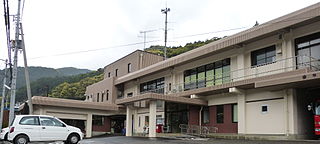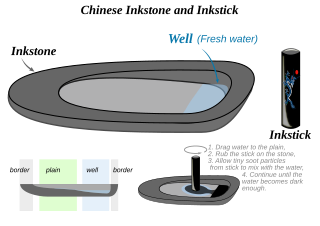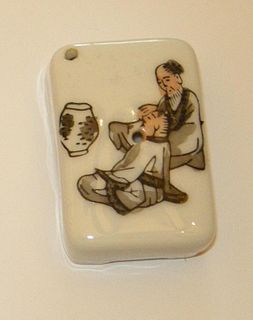Media
| This disambiguation page lists articles associated with the title Inkstone. If an internal link led you here, you may wish to change the link to point directly to the intended article. |
Inkstone most commonly refers to:
| This disambiguation page lists articles associated with the title Inkstone. If an internal link led you here, you may wish to change the link to point directly to the intended article. |

Ink wash painting, or sumi-e, is a type of East Asian brush painting that uses black ink – as used in East Asian calligraphy – in different concentrations. Emerging in Tang dynasty China (618–907), it, and associated stylistic features, overturned earlier, more realistic techniques. These associated features include a preference for shades of black over variations in colour, and an emphasis on brushwork and the perceived "spirit" or "essence" of a subject over direct imitation. It flourished in the Song dynasty (960–1279), as well as Japan after it was introduced by Zen Buddhist monks in the 14th century.

Mihara is a village located in Hata District, Kōchi Prefecture, Japan.

Ogatsu was a town formerly located in Monou District, Miyagi Prefecture, Japan.

Chinese calligraphy is a type of pleasing writing, as well as a kind of sport, embodying the artistic expression of human language in a tangible form. This type of expression has been widely practiced in China and has been generally held in high esteem across East Asia. Calligraphy is considered as one of the four best friends of ancient Chinese literati, along with playing stringed musical instruments, the board game "Go", and painting. There are some general standardizations of the various styles of calligraphy in this tradition. Chinese calligraphy and ink and wash painting are closely related: they are accomplished using similar tools and techniques, and have a long history of shared artistry. Distinguishing features of Chinese painting and calligraphy include an emphasis on motion charged with dynamic life. According to Stanley-Baker, "Calligraphy is sheer life experienced through energy in motion that is registered as traces on silk or paper, with time and rhythm in shifting space its main ingredients." Calligraphy has also led to the development of many forms of art in China, including seal carving, ornate paperweights, and inkstones.

An inkstone is a stone mortar for the grinding and containment of ink.
The Yomiuri Prize for Literature is a literary award in Japan. The prize was founded in 1949 by the Yomiuri Shinbun Company to help form a "strong cultural nation". The winner is awarded two million Japanese yen and an inkstone.

Four Treasures of the Study, Four Jewels of the Study or Four Friends of the Study is an expression used to denote the brush, ink, paper and ink stone used in Chinese and other East Asian calligraphic traditions. The name appears to originate in the time of the Southern and Northern Dynasties.

Inksticks or Ink Cakes are a type of solid ink used traditionally in several East Asian cultures for calligraphy and brush painting. Inksticks are made mainly of soot and animal glue, sometimes with incense or medicinal scents added. To make ink, the inkstick is ground against an inkstone with a small quantity of water to produce a dark liquid which is then applied with an ink brush. Artists and calligraphers may vary the concentration of the resulting ink according to their preferences by reducing or increasing the intensity and duration of ink grinding.

Tianjin Museum is the largest museum in Tianjin, China, exhibiting a range of cultural and historical relics significant to Tianjin. The museum lies in Yinhe Plaza in the Hexi District of Tianjin and covers an area of about 50,000 sq metres. The unique architectural style of the museum, whose appearance resembles that of a swan spreading its wings, has meant that it is quickly becoming one of the city's iconic buildings.
Zhiyanzhai was the pseudonym of an early and mysterious commentator of the 18th-century Chinese novel Dream of the Red Chamber. This person was a contemporary of the author Cao Xueqin who knew the author intimately enough to be regarded as the chief commentator of his work while it was still unpublished. Most early hand-copied manuscripts of the novel contain red or black-inked commentaries by a few unknown commentators, considered authoritative enough to be transcribed by scribes into subsequent generations of copies. Zhiyanzhai was the most prominent of these commentators. Early copies of Dream were known as 脂硯齋重評石頭記. These versions are known as 脂本, or "Rouge Versions", in Chinese. They are the manuscripts with the highest textual reliability.
Luobi Cave is a karst cave under the west face of Yin Ridge (印岭) located 7 km (4.3 mi) north east of Lizhigou Town (荔枝沟镇), 15 km (9.3 mi) from Sanya City, Hainan Province, People's Republic of China.

Taiji Cave is a karst cave located on Shilong Mountain (石龙山) in Guangde County, Xuancheng City, Anhui Province, People's Republic of China, where the provinces of Jiangsu, Zhejiang and Anhui meet. Ming Dynasty writer and poet Feng Menglong described the cave as one of the "Four Absolutes Under Heaven". It is also considered a primary "Place of Enlightenment" by Taoists, similar to the Bodhimanda of Buddhism. The 200-million-year-old cave is divided into dry and wet layers representing the yin and yang of Chinese philosophy.
In February 2004, the Chinese State Council included the cave on its fifth list of National Scenic Attractions. It is also a 4A rated National Tourism Area.
The 16th Golden Rooster Awards, honoring the best in film, were given on 1996, Kunming, Yunnan province.
The following tables compare general and technical features for a number of iOS e-book reader software. Each section corresponds to a major area of functionality in an e-book reader software. The comparisons are based on the latest released version.

The State Bureau of Surveying and Mapping, or the National Bureau of Surveying and Mapping, was the central agency that was responsible for surveying and mapping in the People's Republic of China. It was established in 1959 and was made defunct in March 2018. It was affiliated with the Chinese Academy of Surveying and Mapping (CASM).

A water-dropper is a small device used in East Asian calligraphy as a container designed to hold a small amount of water. In order to make ink a few drops of water are dropped onto the surface of an inkstone. By grinding an inkstick into this water on the inkstone, particles come off and mix with the water, forming ink.
Gu Erniang was a famous Chinese inkstone artist who lived during the reign of Kangxi Emperor. She was the daughter-in-law of the famed inkstone artist Gu Shengzhi and married to her colleague Gu Qiming. During her career, she was regarded as the best of her profession in China.

Suzuri-bako are a type of Japanese writing box. The boxes are traditionally made of lacquered wood and are used to hold writing implements. Historically, the boxes were associated with calligraphy, and as such they were made using high-quality materials designed to safeguard porcelain inkstones (suzuri) from harm.
Inkstone News is an online newspaper platform launched by Hong Kong-based company South China Morning Post Publishers Ltd. in March 2018. It is available as a website and mobile app. Its website uses a JavaScript-enabled interface, and calls itself a "daily digest of China-focused stories". It publishes six items every weekday at 6:00am (ET) on its website, as well as a newsletter and an audio edition on Google Assistant.